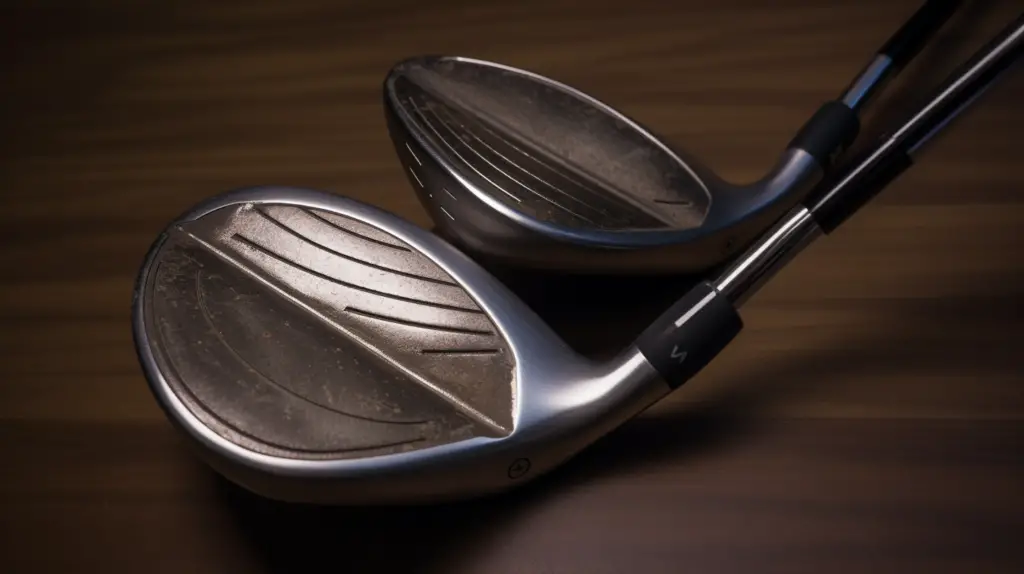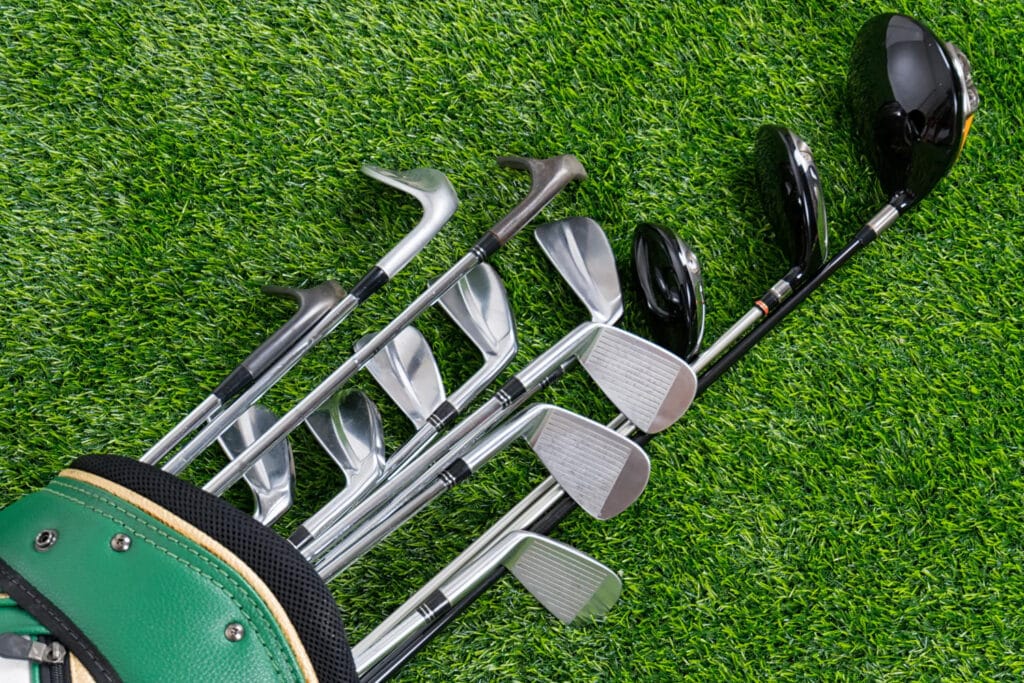Last Updated on November 6, 2023
Golf is a popular sport that many people enjoy around the world. The equipment used in golf, such as clubs and balls, can have a significant impact on performance. Different types of materials are used to make golf clubs, including steel and graphite. This article will discuss which type of material offers better benefits for playing golf: steel or graphite?
Comparison of Weight
The weight of golf clubs, whether they are steel or graphite, can have a significant impact on the game. Steel golf clubs tend to be heavier than their graphite counterparts due to the composition of steel being denser and heavier than graphite. This difference in weight is considered when selecting a club as it may influence swing speed and distance travelled by the ball. The average weight for a steel club is around 360–400 grams, while the equivalent graphite club typically weighs between 250–290 grams.
These differences in club weights should not be disregarded; if a golfer chooses too heavy or light of a club, it could negatively affect their performance. A lighter club will allow for increased acceleration during swings but less control over the accuracy, whereas heavier clubs provide more stability but reduce overall speed. Therefore, determining which type of material and corresponding weight are best suited for an individual’s abilities can greatly improve their success rate on any course.
Comparison of Flexibility
When considering the comparison of flexibility between steel and graphite golf clubs, several factors should be taken into account. The first factor to consider is the type of material that makes up each club. Steel is a much denser metal, providing more weight than graphite, which is lighter in weight when used for golf clubs. Furthermore, this affects the level of flex provided by either club:
- Steel golf clubs are known for their rigid structure and lack of flexibility due to the heavier materials they contain, resulting in less flex on impact with the ball.
- On the other hand, because graphite contains fewer dense metals, it provides a higher degree of flexibility compared to steel clubs; thus allowing players to generate greater power when striking at the ball.
- Moreover, because graphite shafts are thinner than most steel shafts, they provide an improved feel during contact with the ball, which can enhance accuracy and distance control for many golfers.
Overall, there are clear differences between steel and graphite regarding their ability to produce flexible shots, with different levels of force being generated from them depending on how they were designed or manufactured. As such, both types offer distinct advantages as well as potential drawbacks in terms of performance depending on individual preferences or needs while playing golf.
Pros and Cons of Steel Golf Clubs
The flexibility of steel golf clubs compared to graphite makes them more durable than their graphite counterparts. Steel is also known for its forgiveness on off-centre hits, allowing the ball to still travel a good distance and remain in play. Despite having a smaller head size, accuracy with a steel club can be impressive when used correctly. The feel of a steel club is often preferred by many experienced players due to its solid impact sound and feedback from the shot.
On the other hand, there are some drawbacks associated with using steel golf clubs. Weight is one factor that should be considered, as steel heads tend to be heavier than graphite options which may make it difficult for those with slower swing speeds or weaker arms and wrists. In addition, due to its dense material construction, playing shots in cold weather may become uncomfortable if you aren’t wearing gloves, as it will require more strength to hit each shot accurately. Lastly, although not all players mind the sound produced by a metal club upon impact, some golfers find this noise unappealing or distracting while playing their rounds.
Overall, steel clubs have certain pros and cons depending on your individual preferences and need on the course. If you prefer durability over weight considerations and don’t mind the potential clang of impact noises, then they could be an excellent choice for your bag.
Pros and Cons of Graphite Golf Clubs
The use of graphite golf clubs has become increasingly popular in recent years due to the numerous advantages it offers. Graphite shafts are lighter, more flexible, and often have better shock absorption than steel shafts, which makes them ideal for players who need improved accuracy and distance from their shots. Additionally, graphite is much more durable compared to steel, making it a worthwhile investment that can last many rounds without showing signs of wear or tear.
Below is a table outlining some pros and cons of using graphite shafts:
| Pros | Cons |
|---|---|
| Lightweight | Expensive |
| Flexible | Can be difficult to control initially |
| Improved Accuracy and Distance | Less feedback on ball strike |
| More Durable | May not always perform as expected |
| Shock Absorption |
Despite its high cost, the benefits associated with graphite shafts make it an attractive option for most golfers looking to improve their performance and game. The lightweight nature of graphite helps generate greater club head speed during swings while also providing a better feel and stability through impact. Furthermore, the superior durability ensures that you won’t need to replace your equipment anytime soon. All these factors combined mean that investing in graphite may very well give you the edge needed to take your game up a notch.
Cost Considerations

The cost of steel and graphite golf clubs varies from one manufacturer to another. Generally, steel golf clubs are less expensive than graphite ones. The price point for a set of steel clubs is typically lower in comparison to the same set of graphite clubs. Steel clubs may range in price from under $100 to over $500, depending on the brand and quality. Graphite clubs tend to be priced higher; however, there can be significant variations within this category as well. On average, a full set of graphite golf clubs can cost between $300 and $1000, with some brands offering high-end models above that amount.
When considering which type of club would best suit one’s needs and budget, it is important to factor in both upfront costs as well as potential long-term savings resulting from increased performance or reduced maintenance requirements due to material differences.
Expert Advice for Choosing the Right Club
When selecting golf clubs, it is important to know the difference between steel and graphite shafts. Steel shafts are generally more durable than graphite shafts and provide a consistent feel with every shot; however, they also tend to be heavier, which can affect swing speed for some players. Graphite shafts have become popular in recent years due to their lighter weight and improved flexibility that allows for faster swing speeds.
For those looking for advice on golf club selection, seeking out a professional club fitting expert should always be the first step. A qualified expert will help determine what type of clubs best fit your game based on factors such as height, strength, and body type. Additionally, an expert may suggest modifications or customisations to existing clubs if needed. Here are some key tips when considering club selection:
- Have realistic expectations about how different types of clubs will improve performance
- Invest in quality equipment that fits properly
- Try several different styles before making a final decision
Before investing in new golf clubs, it is helpful to consult with an experienced club fitting specialist who can provide personalised guidance and assistance throughout the process. Taking time to understand all aspects of choosing the right clubs will pay dividends down the road by improving playability and optimising overall performance results.
Conclusion
The choice between steel and graphite golf clubs is dependent on an individual’s budget, skill level and preferences. Steel golf clubs tend to be cheaper than graphite ones, but they are heavier in weight, which may make them more difficult for beginners to hit. However, many experienced players prefer the feel of a steel club over that of a graphite one. Graphite golf clubs offer lighter weight options and have a longer lifespan due to their durability. They also generate faster ball speeds and can provide added control when hitting shots. Ultimately, choosing between steel or graphite should come down to personal preference, as each material has its own unique benefits and drawbacks. In order to determine which type of club is best suited for you, it will be important to consider your budget, skill level, playing style and overall comfortability when making this decision.



